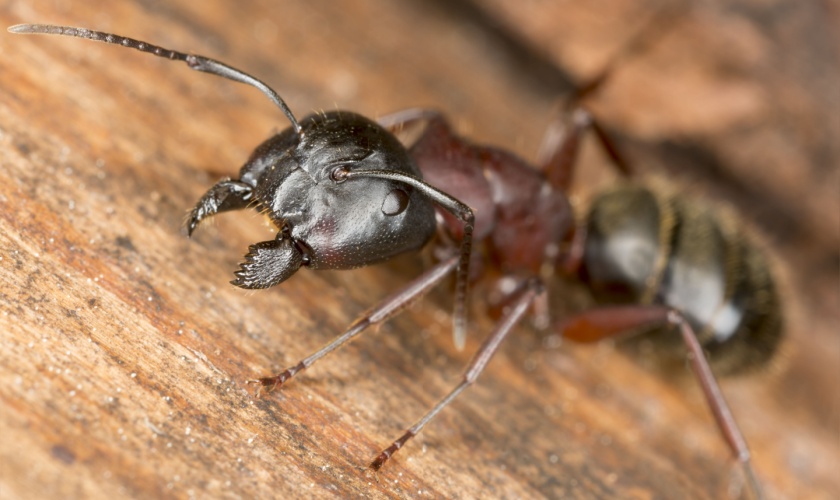Carpenter ants are a common concern for Ann Arbor homeowners, particularly in neighborhoods with mature trees and older homes. These large black or reddish-black ants, measuring up to half an inch in length, often raise alarm bells because of their name and size. But just how worried should you be about potential structural damage if you spot these insects in or around your home? Let’s explore the facts about carpenter ants and the risks they pose to your property.
Understanding Carpenter Ant Behavior
Unlike termites, carpenter ants don’t eat wood. Instead, they excavate it to create nests and galleries for their colonies. This important distinction influences both the type and extent of damage they cause. Carpenter ants:
- Prefer already damaged, moist, or decaying wood
- Create smooth, sandpapered-looking tunnels and galleries
- Leave behind sawdust-like material called frass (a mixture of wood shavings and ant waste)
- Often establish satellite colonies in homes while maintaining the main colony outdoors
In Ann Arbor’s wooded neighborhoods, carpenter ants typically begin in dead trees, stumps, or woodpiles before seeking opportunistic entry into homes.
The Extent of Potential Damage
Yes, Structural Damage Is Possible
The simple answer is yes—carpenter ants can indeed cause structural damage to homes in Ann Arbor. However, several factors influence the severity of this damage:
- Colony size and activity level: Larger, more established colonies create more extensive gallery systems.
- Duration of infestation: Damage accumulates over time, with significant structural concerns typically developing after months or years of untreated activity.
- Location within the structure: Damage to critical support beams poses greater risks than damage to trim or non-load-bearing elements.
- Existing moisture conditions: Carpenter ants prefer damp wood, so homes with moisture issues face accelerated damage.
Comparing Carpenter Ant vs. Termite Damage
For Ann Arbor homes, carpenter ant damage typically progresses more slowly than termite damage, providing homeowners a longer window for detection and treatment before severe structural consequences develop. Even though the damage may come at a slower rate, it is still important to address the issue as soon as possible.
Signs of Carpenter Ant Structural Damage
Vigilant Ann Arbor homeowners should watch for these indicators of carpenter ant activity and potential damage:
- Visual evidence: Large black ants, particularly those with wings (reproductive swarmers, common in spring)
- Frass accumulation: Small piles of sawdust-like material near wooden structures
- Audible clues: Faint rustling sounds within walls, particularly noticeable at night when colonies are most active
- Physical damage: Sagging floors, doors that won’t close properly, or visible tunneling in exposed wood
- Water damage: Since carpenter ants prefer moist wood, water stains often coincide with infestations
Prevention and Protection Strategies
Ann Arbor homeowners can take several proactive steps to prevent carpenter ant damage:
- Eliminate moisture problems: Fix leaking roofs, pipes, and poor drainage that create the damp conditions carpenter ants prefer.
- Remove attractants: Keep firewood elevated and away from the home’s foundation, remove dead tree stumps, and trim branches that contact the house.
- Seal entry points: Caulk cracks and gaps around windows, doors, utility penetrations, and the foundation.
- Regular inspections: Check vulnerable areas like attics, crawl spaces, and areas with previous water damage for early signs of activity.
Professional Intervention
When carpenter ants are discovered, professional assessment and treatment from Honorable Pest Control offers Ann Arbor homeowners several advantages:
- Accurate identification: Confirming carpenter ants versus other wood-destroying insects
- Colony location: Finding the main colony, often hidden outside the home
- Comprehensive treatment: Targeting both visible ants and the hidden colony source
- Preventative recommendations: Addressing conditions that attracted the ants initially
- Structural assessment: Evaluating the extent of any damage
While carpenter ants typically cause less severe and rapid damage than termites, they shouldn’t be ignored. For Ann Arbor homeowners, prompt professional intervention from Honorable Pest Control at the first signs of carpenter ant activity provides the best protection against potential structural damage and ensures your home remains sound and secure.
